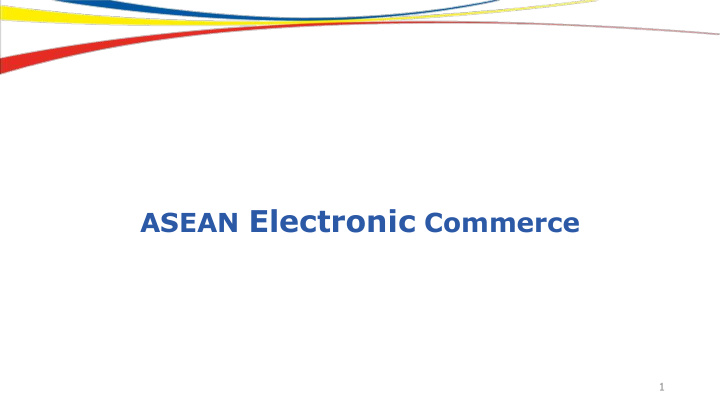



ASEAN Electronic Commerce 1
Background of ASEAN Association of Southeast Asian Nations (ASEAN) – aimed to accelerate economic growth, promote regional peace, active collaboration and assistance and maintain relations between its member states. Consists of 10 nations from the region of Southeast Asia: Brunei, Cambodia, Indonesia, Lao PDR, Malaysia, Myanmar, Philippines, Singapore, Thailand, Vietnam. ASEAN Community in 2015: ASEAN Economic Community (AEC), ASEAN Socio- Cultural Community (ASCC) and ASEAN Political-Security Community (APSC) In 2015, ASEAN Leaders has adopted the AEC Blueprint 2025, which seeks to set out strategic measures and the work plans of various sectoral bodies in ASEAN. 2
Organizational Structure AEC ASEAN Economic Community TELMIN, AEM Ministerial Level TELSOM, SEOM Sectoral Bodies TELSOM-ATRC JWG, ATF-JCC, ACCEC, WC-PSS Relevant Working Groups to related bodies 3
The ASEAN Coordinating Committee on Electronic Commerce Established in 2017 at the 49 th AEM Meeting in Singapore, as a Working - group to push for the ASEAN Work Program on Electronic Commerce - Aimed to coordinate the efforts towards e-Commerce of other relevant working groups within ASEAN - The development plan of multi-sectoral measures to facilitate crossborder e-Commerce in the region, known as the ASEAN Agreement for e- Commerce . 4
ASEAN AGREEMENT ON ELECTRONIC COMMERCE Signed on 22 January 2019 by ASEAN Economic Ministers. ASEAN • Member States are in the process of ratifying the agreement. Objectives: • Facilitate cross-border e-commerce transactions in the ASEAN region; ➢ Contribute to creating an environment of trust and confidence in the ➢ use of e-commerce in the ASEAN region; and Deepen cooperation among Member States to further develop and ➢ intensify the use of e-commerce to drive inclusive growth and narrow development gaps in the ASEAN region. Text of agreement is available on ASEAN website: • http://agreement.asean.org/media/download/20190306035048.pdf 5
ASEAN AGREEMENT ON ELECTRONIC COMMERCE Cross-border facilitation Transparency Cybersecurity Key Elements Stakeholder Electronic Engagement payment Cooperation 6
ASEAN DIGITAL INTEGRATION FRAMEWORK Adopted by the ASEAN Economic Ministers on 29 August 2018. • Priority areas: • Facilitate seamless trade ➢ Protect data while supporting digital trade and innovation ➢ Enable seamless digital payments ➢ Broaden digital talent base ➢ Foster entrepreneurship ➢ Coordinate actions ➢ Action Plan targeted for completion within 2019. • 7
Recommend
More recommend